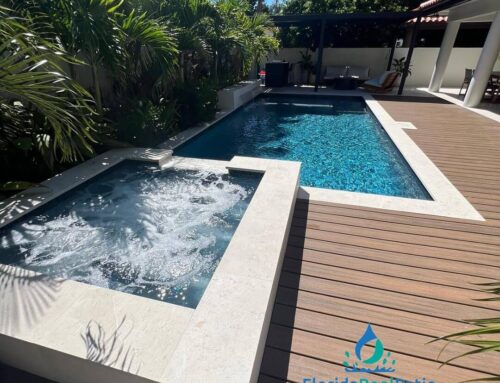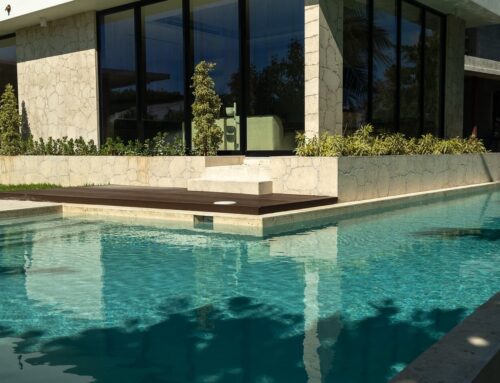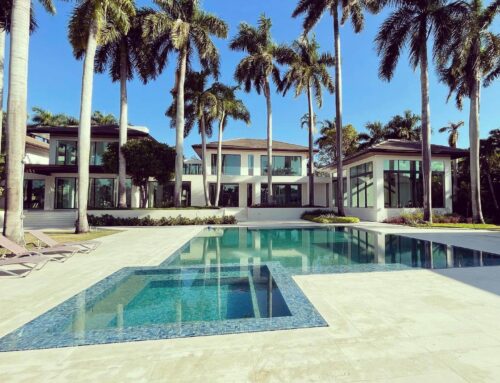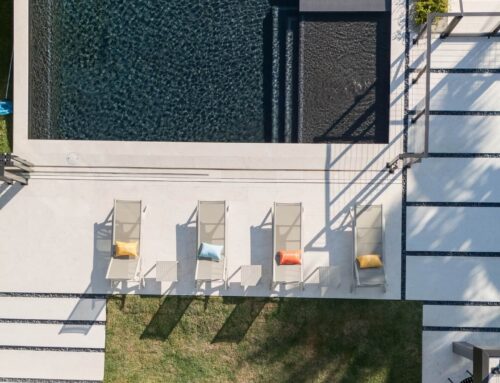Sometimes, unwanted visitors crash pool parties. If you spot pink streaks along your pool’s edges or what looks like pinkish algae on the water’s surface, it’s time to show these guests the exit.
Pink algae is a common issue, but it’s preventable. Whether you use biguanide or chlorine to clean your pool, you can get rid of it with just eight simple steps. Soon enough, your pool will be safe to swim in again.
First, let’s figure out what this algae is.
GET A FREE QUOTE
CONTACT US AT (305) 590-5263
What Is Pink Algae?
Pink algae is actually a type of bacteria. Despite its name, pink algae is not a true algae. It is commonly found in moist environments and is known for its distinctive pink or reddish slime that can adhere to pool walls, crevices, and corners. This bacterium thrives in environments with minimal water circulation, which is why it often appears in less active parts of a pool. It can be particularly troublesome because it forms a protective layer that makes it resistant to typical chlorine levels used in pool maintenance.
Regular, thorough cleaning and maintaining proper water chemistry are essential for controlling and preventing the spread of pink algae in swimming pools.
Why Does My Pool Have Pink Algae?
Pink algae appear in your pool due to a combination of factors that create a favorable environment for its growth. This bacterium thrives in warm, moist conditions with low water circulation, making swimming pools, particularly those with inadequate filtration and circulation, a perfect breeding ground. Insufficient chlorine levels also allow pink algae to establish itself, as it can resist lower concentrations of pool sanitizers.
Additionally, the presence of phosphates and other organic materials can nourish these bacteria, promoting their proliferation. Ensuring that your pool’s water chemistry is balanced and the filtration system is functioning properly are key steps to prevent pink algae from taking hold.
Is Pink Algae Harmful?
Having pink algae in your pool is not just gross—it’s also dangerous. Serratia Marcescens, the bacteria responsible, can enter your body through your nose, eyes, or any open wounds. Once inside, it can lead to various illnesses like urinary and respiratory infections, endocarditis, and wound infections.
If you spot pink algae, it’s best to avoid swimming until it’s gone. And once you’ve cleared it out, you’ll want to keep it away. It’s all about ensuring your safety and the safety of others who swim in your pool.

How to Get Rid of Pink Algae in Your Pool
Ready to make your pool safe for swimming again? You’re not alone. All you’ll need are your regular pool chemicals, a 360-degree brush, and an algaecide.
1. Purge Out the Algae from Your Pool Filter
Understanding why this step is so important involves knowing how your pool filter operates. While sanitizer tackles tiny bacteria, it doesn’t physically remove them. That’s where your pool filter comes in. It’s designed to capture larger particles, like pink algae, as water cycles through.
Here’s the catch: if your pool has pink algae, chances are your filter does too. If you have a sand or D.E. filter, it’s time to backwash it. For a cartridge filter, you’ll need to clean or replace the filter media.
This step prevents the filter from reintroducing pink algae into your pool. Trust me, nobody wants that nasty cycle to continue.
2. Stabilize Your Pool Water
If you’re dealing with pink algae, it’s likely that your pool’s chemical balance is disrupted. This isn’t just a minor issue—it’s significant. The chemical imbalance that allows pink algae to thrive can also compromise the overall health of your pool. Moreover, pink algae are known to rapidly consume sanitizers and other chemicals, quickly destabilizing your pool’s chemistry. This bacteria is quite adept at utilizing resources!
Now is an ideal time to check and adjust your chemical levels, particularly the pH of your pool. Pink algae can significantly alter pH levels. Ideally, you should maintain a pH between 7.4 and 7.6, with 7.5 being optimal.
3. Turn Off the Pump
Pump it down. For these next steps, we’ll need calm waters. The process is about to get real, and it will require a lot of hard work. From now on, everything you do will count.
4. Brush Out the Pool
To effectively tackle pink algae in your pool, start with a thorough brushing of the pool’s surfaces. Using a stiff pool brush, scrub all areas affected by the algae, especially the corners and crevices where it tends to accumulate. This physical removal is crucial as it dislodges the algae’s protective slime layer, making it more vulnerable to sanitizers.
Ensure you cover every part of your pool, including the steps and hidden spots that are often overlooked, to prevent the algae from re-establishing itself.
5. Add the Chemicals and Take a Break
What about those products I mentioned earlier that claim to kill pink algae, even though it’s not a real thing? It’s worth trying one of these products now. Despite the mislabeling, they’re still very effective. We could use all the help we can get.
Next up: shocking your swimming pool. And by shock, I mean shock it—like tripling or even quadrupling the amount of pool shock you usually use.
Remember to always shock your pool in the evening or at night, or else the sun will neutralize it. This time, we need it to work effectively. After adding the shock, test the water to ensure the chlorine level is around 5 parts per million (ppm). Let the shock sit in your pool for a few hours, and keep the pump turned off!
6. Vacuum the Pool
This part won’t be too tough. However, it won’t work with an automatic cleaner. You might have already opted for a robotic vacuum to spare yourself time and effort. But now, it’s time to bring out the manual vacuum.
It’s probably been a while since you last used it, and hopefully, it’ll be a long while before you need to again.
When using the manual vacuum, make sure to vacuum all the way to waste. Don’t let what you’re vacuuming end up back in your pool. If your water level has dropped below the line, top it up with a garden hose fitted with a metal filter.
7. Clean the Filter Again
After initially addressing the algae, it’s crucial to clean your pool filter a second time. Make sure to use a cleaner that is specifically formulated for the type of filter you have—whether it’s sand, cartridge, or diatomaceous earth. This ensures that any lingering algae or debris that might have been missed during the first cleaning are thoroughly removed.
Re-cleaning your filter is a pivotal step that helps maintain the cleanliness of your pool and ensures a safer, more enjoyable swimming experience.
8. Run the Pump and Keep It Balanced
It’s finally time to fire up the engine again. But hold on, you’re not quite finished yet. You’ll need to brush and vacuum your pool twice a day for about a week to make sure all that pink algae is gone. Keep an eye on your water level and check it frequently. Also, test your water every two days. During this time, aim for chlorine levels of around 5 ppm.
After a week of diligent cleaning, let your chlorine levels go back to normal and rebalance your water. The algae is finally history, and your pool is safe once more!

Prevention Is Better Than a Cure!
Keeping pink algae at bay is far simpler than eradicating it once it takes hold. With consistent maintenance, you can ensure your pool remains pristine. Regular brushing, at least three times a week, and weekly vacuuming are fundamental. If you have an automatic cleaner, it can handle the vacuuming for you. It’s also vital to maintain the chemical balance of your pool; consider a weekly shock treatment, or if you use biguanide, an oxidizer might be more appropriate.
Staying on top of these tasks is straightforward and essential, especially if you’ve faced algae issues before. Learning the basics of pool maintenance can prevent future outbreaks, ensuring your pool is always ready for a swim. For expert advice and professional services, consider reaching out to Florida Pool Patio, where maintaining beautiful pools is our specialty!
Our Pool Services in South Florida
GET A FREE QUOTE
CONTACT US AT (305) 590-5263






